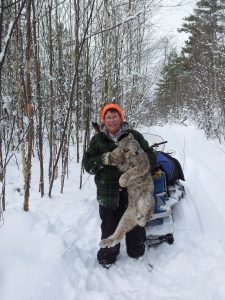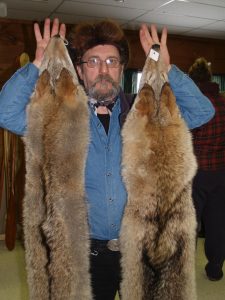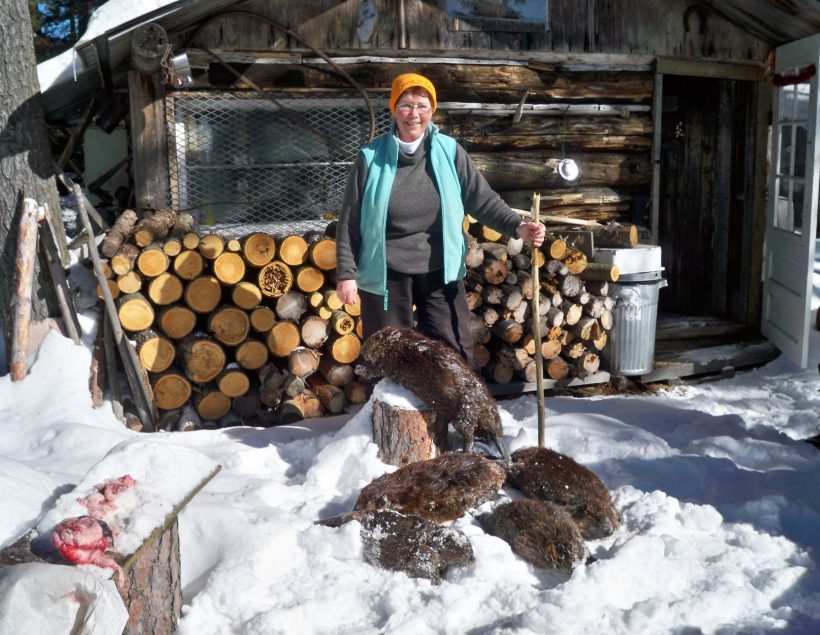REQUIEM FOR TWO OLD TRAPPERS by Ralph Bice
From December 14, 1977
Recently I tried to explain why so many of us still continue to go trapping. There are many things to see and enjoy. Many of these small sights would be very mild compared to some of the architectural wonders as well as some of the natural wonders that are on view to the public in many places. Only the things trappers see and remember from year to year are for the most part private showings.
A person has to have a bit of courage nowadays to admit that he or she is following man’s oldest calling, and in fact the industry that put Canada on the map in the first place. There has been so much adverse publicity about trapping that portrays it as a cruel and terrible occupation.
Anyone who reads the Toronto Star and follows the page where people write in letters saw a few weeks back a very strong reaction to a speech the O.T.A. (Ontario Trappers’ Association) president made. Letters from a group that would have trapping banned, even went so far as to refer to trappers as assassins.
Then, only a short while back, some one came up with the opinion that anyone with less than a grade nine education had to be considered illiterate. Now the younger men who go trapping may have been to high school but those of us who were born early in this century did not, or very few. In fact many did not get as far as grade 8. One of the first directors of the O.T.A. could neither read nor write yet for many years he helped with putting the association on a firm basis, even to travelling around showing better methods to other trappers who are just considered a bunch of illiterate assassins.

Let’s look at a few facts. It was trappers who finally talked the Department of Lands and Forests into setting up trapping zones and they proved so successful that the idea has been copied in other provinces. That was in 1943. Then in 1947 it was trappers who got together in Sudbury and founded the O.T.A. which again has been copied by all the other nine provinces and by some of the states to the south. Records, available at Queen’s Park, show that more fur was taken than ever before. Also, there are perhaps more fur bearing animals in Ontario than in any time in recorded history.
The largest raw fur auction house in the world is at North Bay, owned and operated by the trappers. Classes are held every year to help improve the quality of pelts offered for sale.
In the early fifties came the Conibear trap, invented by Frank Conibear, also a Canadian trapper. This has been a boon to trappers as it is a quick kill device and very seldom does any animal get away.
So trapping has been put on a sound business foundation in taking, handling and selling wild furs. And all this by a group that some would have you believe are not only assassins but uneducated.
But I had intended to write about two old friends who have gone on. I am referring to the late George McKee of Biscotasing and Guilford Brooks of Huntsville. These two men were in some ways similar. When they attended conventions or trappers’ meetings they were always on time. And always trying to get things done. Neither man sought, or would take an office but were always ready with help and advice to those willing to learn. Both were considered top men in their work and both were among the top skinners. For many years George was the winner of the skinning contest when the conventions were held in Sudbury, beaten once by his son.
George McKee was one of a large family raised in the Loring area. They lived for many years at Metagami and the 12 children plus one adopted received their education by correspondence courses, so well that some have gone into the business world.
I visited the McKee’s at their home in Biscotasing a few years back when I was getting information for the O.T.A. history. George had quit trapping as he was well past 80. We could have talked for days and still there would have been things to discuss. One of his daughters told me that as a teenager she liked the spring muskrat trapping. What she liked best was the twice daily meals of friend muskrats. She too is gone.
George died several months ago following surgery. As a trapper, guide and outdoorsman he was tops in his field.
Guilford Brooks died only a week ago. He had not been in good health for several years but he kept on trapping. He was tops in his work, both taking and preparing pelts. He was one of the very few still left that attended the first setting up of zones in Huntsville in 1943. Some years back he started making canoes, the well-known Northland. Failing health caused him to sell to Albert Maw, another trapper.
He admitted it was getting tougher to get along in the woods but said he would trap as long as he could. And he did. He had been checking traps and did not return. A search found him beside the trail just as he had fallen off his snowmobile. So another of the old trappers is gone. But what a way to go. To be doing something you liked doing. To be happy, content and then without pain or suffering be in the Happy Hunting Grounds in seconds. Who could ask for a nicer exit?

So two more of the long-time trappers have gone and there are fewer of us each year. Words cannot replace an empty chair but these two men certainly did their best in putting their chosen calling on record as being an honourable profession.
